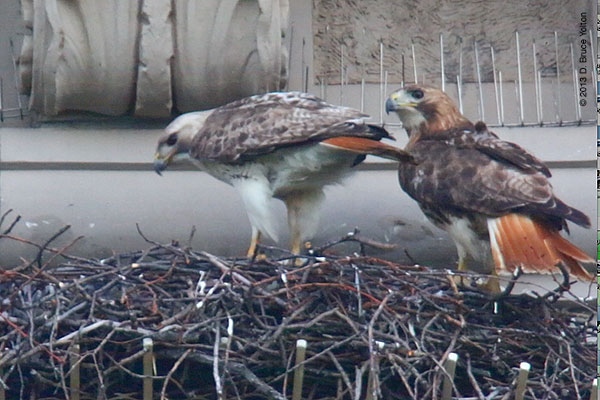
Corey Finger posted an interesting, but controversial, blog post about Pale Male entitled “Pale Male Is Dead: Long Live Pale Male!” on the 10,000 Birds blog a few days ago.
He asks an excellent question. Could Pale Male actually be Pale Male II, or even the Pale Male III? It certainly is a question worth asking, and one that might have an unpopular answer.
Manhattan hawk watchers have seen hawks replace mates in under 24 hours. There were fast replacements of partners at both the St. John the Divine and Washington Square Park nests in recent years. So, a quick switch of hawks is certainly possible.
Most New York City nests, which are usually characterized as long-term monogamous triumphs, have actually had a good number of mate changes due to the mortality of partners. So, Corey’s question is a good one. Could a look alike have replaced the original Pale Male? Maybe during the off-season, when a missing hawk would have gone unnoticed?
Corey brings up Pale Male’s unusually long lifespan, the ratio of his mates to himself (8:1), to cast doubt, then questions if Pale Male, who hasn’t been banded, really has enough unique plumage markers to determine if he’s the same bird that appeared in Central Park in 1991?
Corey also implied something I’ve always been concerned about, which is “Can those who believe in the myth of Pale Male also be good observers of him?”
So, could Corey be right? Maybe.
First let’s look at Pale Male’s plumage. Unfortunately, Corey quotes from Marie Winn’s book to find a description of how Pale Male looked in the “old days”. Marie loves to spin a good story, sometimes at the sake of accuracy. So I think it would be best not to use her anthropomorphically entitled Red-tails in Love, as scientific source material. If you want to compare the plumage of Pale Male, year over year, one can use the footage of Pale Male from Frederic Lilien’s 2004 Nature episode and compare it to photographs and footage from today. I believe the DVD is on Netflix! (But even doing this leave a huge gap for the first decade of Pale Male’s life.)
(In the early nineties, Pale Male arrived and was lighter than the hawks in the guidebooks, so he was dubbed Pale Male by Marie Winn. However, Pale Male’s light color is not that unusual for a mid-Atlantic hawk. His light coloring is fairly common. It is part of the myth of Pale Male that his coloring is rare.)
Both from this older era and today, the plumage is very consistent to my eyes. Light scalloped feathers (with a oak leaf like patterns) on his lower breast and light head color, which is almost golden in the right light, are consistent in both periods. But even day-to-day, Pale Male has lots of different looks depending on the temperature or the lighting. He doesn’t have any truly unique field marks.
Secondly, the passing of so many mates is hard to explain, but how all of these hawks got into trouble isn’t just rat poison. Pale Male could just have some great luck. But other issues come into play too. New York City seems to have greater death by rodenticides in females, especially before nesting. There have been lots of necropsies where females bleed out via their ovaries. Could males have it easier in NYC?
Thirdly, we have Pale Male’s long life span. Pale Male should be living a long life, in one of the richest zip codes in America. He lives in a very safe area, with a great food supply.
So, is Corey right? He builds a good case, but it isn’t solid. Maybe enough evidence to win a civil trail, but certainly not enough to win a criminal case.
But I do know one thing, if this discussion upsets you, then you’re not someone who should be sitting on the jury. Maybe you’re too attached to the myth of Pale Male to judge fairly.
Update: Since I first posted this, I’ve run into some of the long term Pale Male followers in Central Park. Those that have followed him since 1992 when he arrived and 1993 when the nest was built on 5th Avenue. Although they don’t have pictures online, they do have slides and prints that show what Pale Male looked like in the early days. Having talked to these unbiased observers of Pale Male, I now believe that we are viewing the same individual, not two. It would be great if one of them could collect some photos and put them online to put this question to rest.